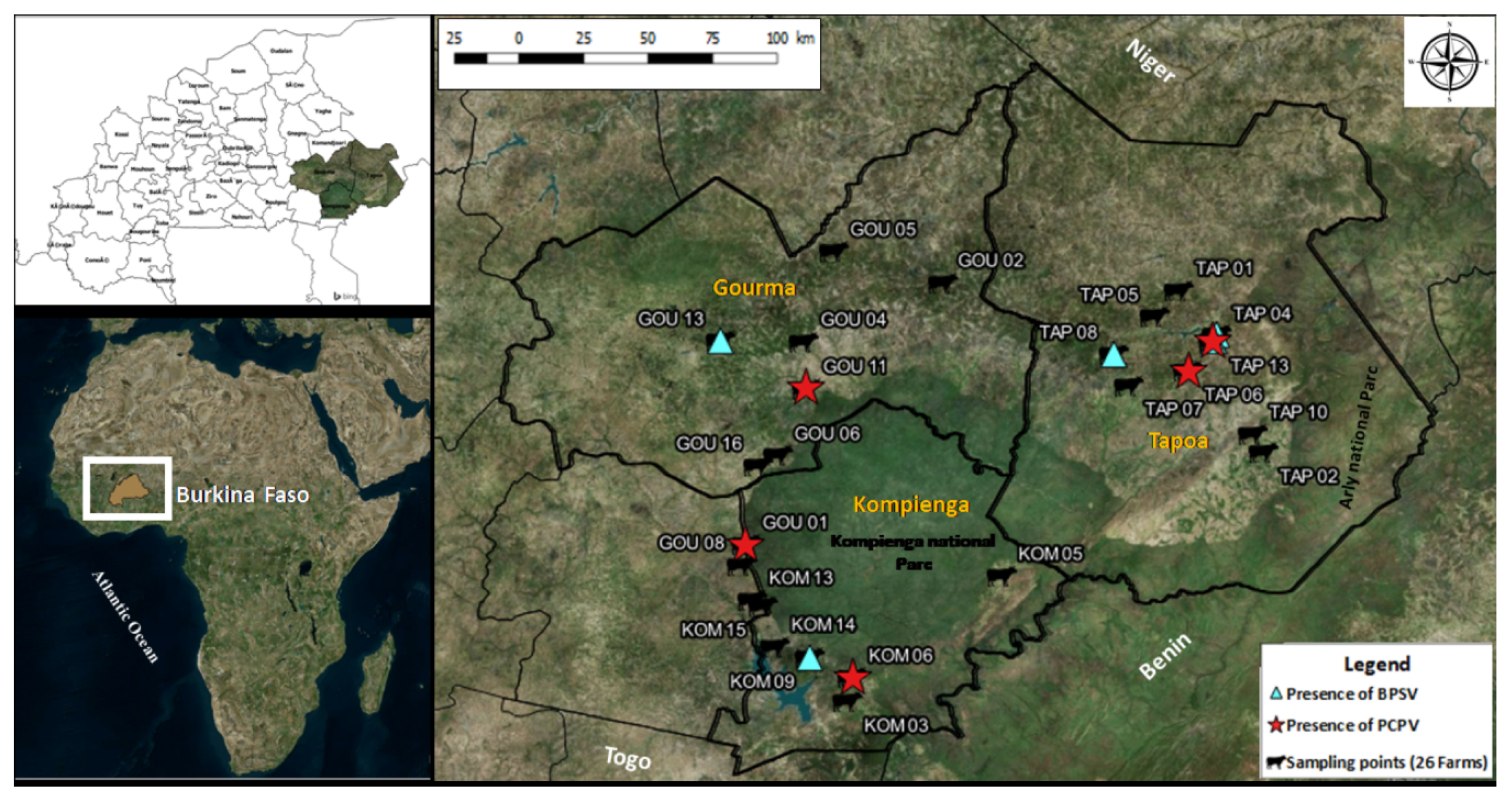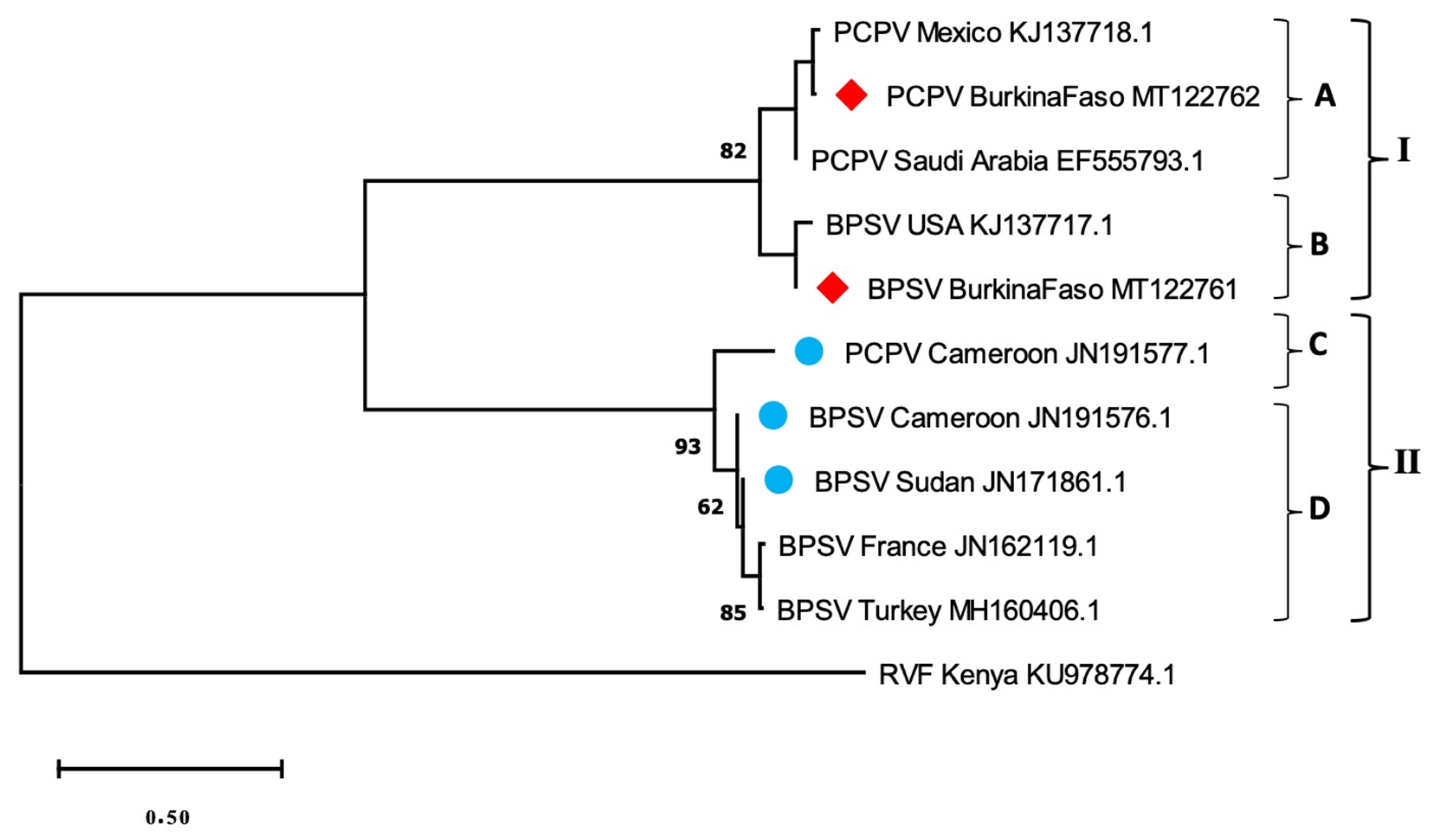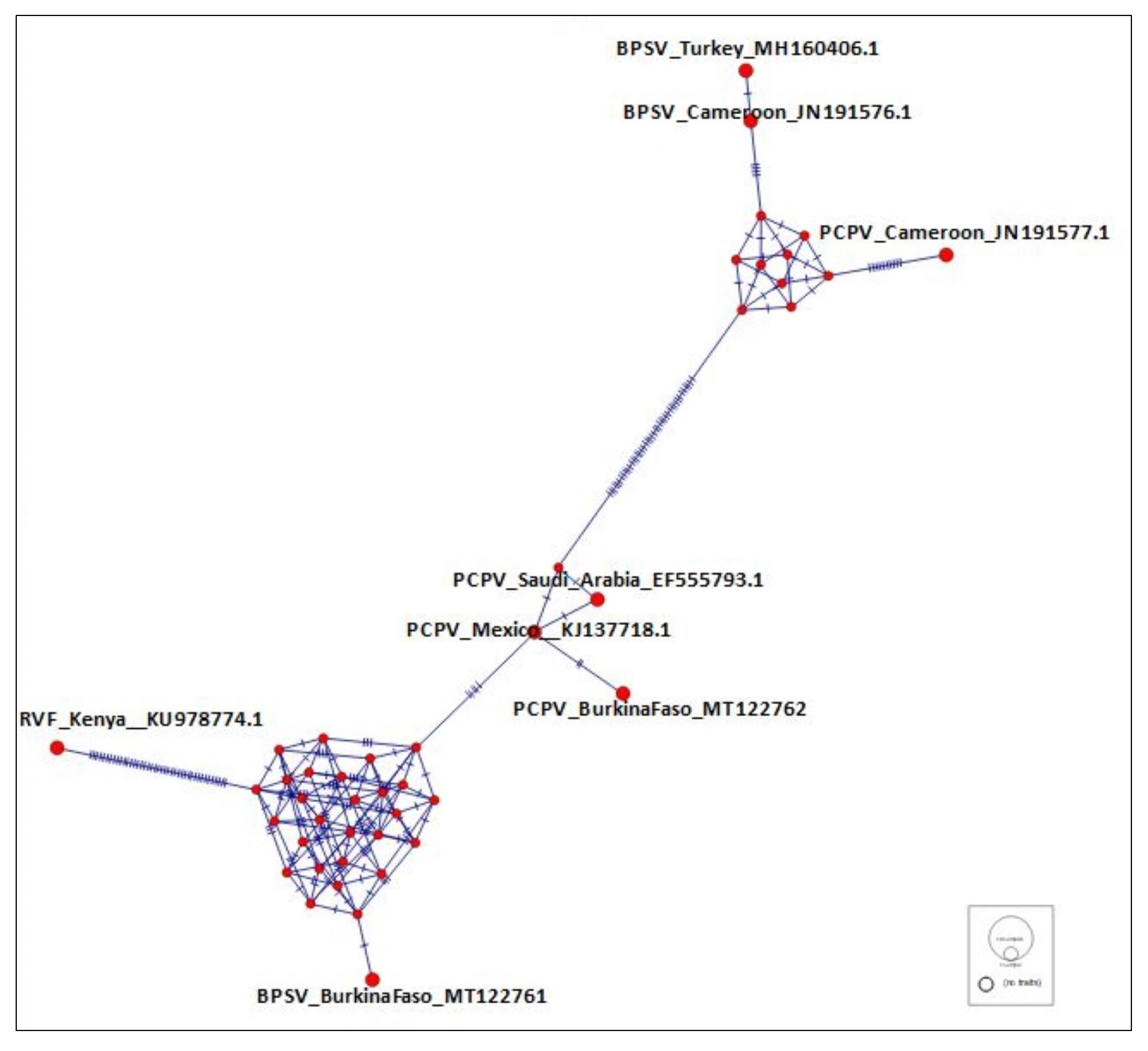Detection of Two Species of the Genus Parapoxvirus (Bovine Papular Stomatitis Virus and Pseudocowpox Virus) in Ticks Infesting Cattle in Burkina Faso
Abstract
1. Introduction
2. Materials and Methods
2.1. Ticks Collection and Morphological Identification
2.2. Nucleic Acids Extraction
2.3. Real-Time PCR
2.4. Phylogenetic Analysis
3. Results
3.1. Ticks Collection and Identification
3.2. Viruses Detected in Ticks
3.3. Phylogenetic Analysis
4. Discussion
Author Contributions
Funding
Acknowledgments
Conflicts of Interest
References
- Nugteren, H.; Le Côme, C. Libérer le Potentiel du Pastoralisme Pour Développer L’afrique de l’Ouest; Fred Zaal, Thea Hilhorst et Jacqueline Sluijs; KIT and SNV: Amsterdam, The Netherlands, 2016. [Google Scholar]
- Venter, M. Assessing the zoonotic potential of arboviruses of African origin. Curr. Opin. Virol. 2018, 28, 74–84. [Google Scholar] [CrossRef]
- Swei, A.; Couper, L.I.; Coffey, L.L.; Kapan, D.; Bennett, S. Patterns, drivers, and challenges of vector-borne disease emergence. Vector-Borne Zoonotic Dis. 2020, 20, 159–170. [Google Scholar] [CrossRef]
- Fall, G.; Di Paola, N.; Faye, M.; Dia, M.; de Melo Freire, C.C.; Loucoubar, C.; de Andrade Zanotto, P.M.; Faye, O. Biological and phylogenetic characteristics of West African lineages of West Nile virus. PLoS Negl. Trop. Dis. 2017, 11. [Google Scholar] [CrossRef]
- Favier, C.; Chalvet-Monfray, K.; Sabatier, P.; Lancelot, R.; Fontenille, D.; Dubois, M.A. Rift Valley fever in West Africa: The role of space in endemicity. Trop. Med. Int. Heal. 2006, 11, 1878–1888. [Google Scholar] [CrossRef] [PubMed]
- Filippitzi, M.E.; Goumperis, T.; Robinson, T.; Saegerman, C. Microbiological Zoonotic Emerging Risks, Transmitted Between Livestock Animals and Humans (2007–2015). Transbound. Emerg. Dis. 2017, 64, 1059–1070. [Google Scholar] [CrossRef] [PubMed]
- Underwood, W.J.; Blauwiekel, R.; Delano, M.L.; Gillesby, R.; Mischler, S.A.; Schoell, A. Biology and Diseases of Ruminants (Sheep, Goats, and Cattle). In Laboratory Animal Medicine; Elsevier: Amsterdam, The Netherlands, 2015; pp. 623–694. [Google Scholar]
- Sule, W.F.; Oluwayelu, D.O.; Hernández-Triana, L.M.; Fooks, A.R.; Venter, M.; Johnson, N. Epidemiology and ecology of West Nile virus in sub-Saharan Africa. Parasit. Vectors 2018, 11, 414. [Google Scholar] [CrossRef] [PubMed]
- Huang, T.; Tulman, E.R.; Diel, D.G.; Khatiwada, S.; Sims, W.; Edwards, J.F.; Wen, X.; Kutish, G.F.; Rock, D.L.; Delhon, G. Coinfection with multiple strains of bovine papular stomatitis virus. Arch. Virol. 2015, 160, 1527–1532. [Google Scholar] [CrossRef]
- Büttner, M.; Rziha, H.-J. Parapoxviruses: From the Lesion to the Viral Genome. J. Vet. Med. Ser. B 2002, 49, 7–16. [Google Scholar] [CrossRef]
- Poxviridae. In Fenner’s Veterinary Virology; Elsevier: Amsterdam, The Netherlands, 2017; pp. 157–174.
- Walker, A.R.; Bouattour, A.; Camicas, J.L.; Estrada-Peña, A.; Horak, I.; Latif, A.A.; Pegram, R.G.; Preston, P.M. Ticks of Domestic Animals in Africa: A Guide to Identification of Species; Bioscience Reports: Edinburgh, UK, 2014. [Google Scholar]
- Zhao, H.; Wilkins, K.; Damon, I.K.; Li, Y. Specific qPCR assays for the detection of orf virus, pseudocowpox virus and bovine papular stomatitis virus. J. Virol. Methods 2013, 194, 229–234. [Google Scholar] [CrossRef]
- Drosten, C.; Göttig, S.; Schilling, S.; Asper, M.; Panning, M.; Schmitz, H.; Günther, S. Rapid detection and quantification of RNA of Ebola and Marburg viruses, Lassa virus, Crimean-Congo hemorrhagic fever virus, Rift Valley fever virus, dengue virus, and yellow fever virus by real-time reverse transcription-PCR. J. Clin. Microbiol. 2002, 40, 2323–2330. [Google Scholar] [CrossRef]
- Wölfel, R.; Paweska, J.T.; Petersen, N.; Grobbelaar, A.A.; Leman, P.A.; Hewson, R.; Georges-Courbot, M.C.; Papa, A.; Günther, S.; Drosten, C. Virus Detection and Monitoring of Viral Load in Crimean-Congo Hemorrhagic Fever Virus Patients. Emerg. Infect. Dis. 2007, 13, 1097–1100. [Google Scholar] [CrossRef] [PubMed]
- Nitsche, A.; Büttner, M.; Wilhelm, S.; Pauli, G.; Meyer, H. Real-Time PCR Detection of Parapoxvirus DNA. Clin. Chem. 2006, 52, 316–319. [Google Scholar] [CrossRef] [PubMed]
- Kulesh, D.A.; Baker, R.O.; Loveless, B.M.; Norwood, D.; Zwiers, S.H.; Mucker, E.; Hartmann, C.; Herrera, R.; Miller, D.; Christensen, D.; et al. Smallpox and pan-orthopox virus detection by real-time 3′-minor groove binder TaqMan assays on the roche LightCycler and the Cepheid smart Cycler platforms. J. Clin. Microbiol. 2004, 42, 601–609. [Google Scholar] [CrossRef] [PubMed]
- Cook, S.; Moureau, G.; Harbach, R.E.; Mukwaya, L.; Goodger, K.; Ssenfuka, F.; Gould, E.; Holmes, E.C.; de Lamballerie, X. Isolation of a novel species of flavivirus and a new strain of Culex flavivirus (Flaviviridae) from a natural mosquito population in Uganda. J. Gen. Virol. 2009, 90, 2669–2678. [Google Scholar] [CrossRef] [PubMed]
- Lambert, A.J.; Lanciotti, R.S. Consensus Amplification and Novel Multiplex Sequencing Method for S Segment Species Identification of 47 Viruses of the Orthobunyavirus, Phlebovirus, and Nairovirus Genera of the Family Bunyaviridae. J. Clin. Microbiol. 2009, 47, 2398–2404. [Google Scholar] [CrossRef]
- Sohier, C.; Haegeman, A.; Mostin, L.; De Leeuw, I.; Van Campe, W.; De Vleeschauwer, A.; Tuppurainen, E.S.; van den Berg, T.; De Regge, N.; De Clercq, K. Experimental evidence of mechanical lumpy skin disease virus transmission by Stomoxys calcitrans biting flies and Haematopota spp. horseflies. Sci. Rep. 2019, 9, 20076. [Google Scholar] [CrossRef]
- Kabore, H.; Salembere, M.S.; Tamboura, H.H. Seasonal Variation of Ticks on Cattle in Burkina Faso. Ann. N. Y. Acad. Sci. 1998, 849, 398–401. [Google Scholar] [CrossRef]
- Stachurski, F. Invasion of West African cattle by the tick Amblyomma variegatum. Med. Vet. Entomol. 2000, 14, 391–399. [Google Scholar] [CrossRef]
- Sprygin, A.; Pestova, Y.; Wallace, D.B.; Tuppurainen, E.; Kononov, A.V. Transmission of lumpy skin disease virus: A short review. Virus Res. 2019, 269, 197637. [Google Scholar] [CrossRef]
- Laguardia-Nascimento, M.; Sales, É.B.; Gasparini, M.R.; de Souza, N.M.; da Silva, J.A.; Souza, G.G.; Carani, F.R.; dos Santos, A.F.; Rivetti Júnior, A.V.; Camargos, M.F.; et al. Detection of multiple viral infections in cattle and buffalo with suspected vesicular disease in Brazil. J. Vet. Diagn. Investig. 2016, 28, 377–381. [Google Scholar] [CrossRef]
- Rheinbaben, F.V.; Gebel, J.; Exner, M.; Schmidt, A. Environmental resistance, disinfection, and sterilization of poxviruses. In Poxviruses; Mercer, A.A., Schmidt, A., Weber, O., Eds.; Birkhäuser: Birkhäuser, Basel, 2007; pp. 397–405. [Google Scholar]
- Madder, M.; Adehan, S.; de Deken, R.; Adehan, R.; Lokossou, R. New foci of Rhipicephalus microplus in West Africa. Exp. Appl. Acarol. 2012, 56, 385–390. [Google Scholar] [CrossRef] [PubMed]
- Hanotte, O.; Bradley, D.G.; Ochieng, J.W.; Verjee, Y.; Hill, E.W.; Rege, J.E.O. African Pastoralism: Genetic Imprints of Origins and Migrations. Science (80-.) 2002, 296, 336–339. [Google Scholar] [CrossRef] [PubMed]
- Lederman, E.R.; Tao, M.; Reynolds, M.G.; Li, Y.; Zhao, H.; Smith, S.K.; Sitler, L.; Haberling, D.L.; Davidson, W.; Hutson, C.; et al. An Investigation of a Cluster of Parapoxvirus Cases in Missouri, Feb–May 2006: Epidemiologic, Clinical and Molecular Aspects. Animals 2013, 3, 142–157. [Google Scholar] [CrossRef] [PubMed]
- Boussini, H.; Lamien, C.E.; Nacoulma, O.G.; Kabore, A.; Poda, G.; Viljoen, G.J. Prevalence of Rift Valley fever in domestic ruminants in the central and northern regions of Burkina Faso: -EN- -FR- Prévalence de la fièvre de la vallée du Rift chez les ruminants domestiques dans les régions centrale et septentrionale du Burkina Faso -ES- Prevalencia de la fiebre del Valle del Rift en rumiantes domésticos de las regiones central y septentrional de Burkina Faso. Rev. Sci. Tech. L’oie 2014, 33, 893–901. [Google Scholar] [CrossRef]



| Genus or Species | Primer/Probe | 5′→3′ Sequence | Target | Position | Amplicon Size (bp) | Concentration | Reference |
|---|---|---|---|---|---|---|---|
| Pan-Parapox viruses | Forward | TCGATGCGGTGCAGCAC | B2L | 599–683 | 85 | 7.5 pmol | [16] |
| Reverse | GCGGCGTATTCTTCTCGGAC | 7.5 pmol | |||||
| Probe | FAM-TGCGGTAGAAGCC-NFQ-MGB | 2.5 pmol | |||||
| Pan-Parapox viruses | Forward | CGCGGTCTGGTCCTTG | J6R | 771–855 | 85 | 0.4 µmol | [13] |
| Reverse | CAGCATCAACCTCTCCTACATCA | 0.4 µmol | |||||
| Probe | FAM-CCACGAAGCTGCGCAGCAT-BHQ1 | 200 nmol/L | |||||
| Orf virus (ORF) | Forward | GAGTTCGAGGAGATGATCTTGA | ORFV_J6R | 697–764 | 68 | 0.4 µmol | |
| Reverse | FAM-GCCGAGGAGCAGGTCA | 0.4 µmol | |||||
| Probe | CTCGATCACGGCGCGCT-BHQ1 | 200 nmol/L | |||||
| Bovine papular stomatitis virus (BPSV) | Forward | GAGATGATCTTGATGTTGTCGTACT | BPSV_J6R | 665–755 | 91 | 0.4 µmol | |
| Reverse | FAM-TGGGCATGATCGTGAAGTAC | 0.4 µmol | |||||
| Probe | ATCATCGCGCGCTGGATCAC-BHQ1 | 200 nmol/L | |||||
| Pseudocowpox virus (PCPV) | Forward | CCGACTACATCCGGAACA | PCPV_J6R | 62609–62675 | 67 | 0.4 µmol | |
| Reverse | CGCACGCGCTTGCT | 0.4 µmol | |||||
| Probe | FAM-CTCACGCAGAAGATCTTCGTGAACTAC-BHQ1 | 200 nmol/L | |||||
| pan-Orthopox virus | OPE9L-F1880 | GAA CAT TTT TGG CAG AGA GAG CC | HA (J7R) | 177 | 0.5 µM | [17] | |
| OPE9L-R2057 | CAA CTC TTA GCC GAA GCG TAT GAG | 0.5 µM | |||||
| OPE9L-p1924S-MGB | FAM-CAG GCT ACC AGT TCA A-MGBNFQ | 0.1 µM | |||||
| Pan-Flaviviruses | PF1 | TGYRTBTAYAACATGATGGG | NS5 | 93 | 20 µM | [18] | |
| PF2 | GTGTCCCADCCDGCDGTRTC | 20 µM | |||||
| Rift Valley Fever Virus | RVS | AAAGGAACAATGGACTCTGGTCA | G2 | 349–417 | 94 | 1 µM | [14] |
| RVAs | CACTTCTTACTACCATGTCCTCCAAT | 1 µM | |||||
| RVP | AAAGCTTTGATATCTCTCAGTGCCCCAA | 0.2 µM | |||||
| Crimean-Congo Hemorrhagic Fever Virus | RWCF | CAAGGGGTACCAAGAAAATGAAGAAGGC | S | 1068–1223 | 181 | 600 nM | [15] |
| RWCR | GCCACAGGGATTGTTCCAAAGCAGAC | 600 nM | |||||
| SE01 | FAM-ATCTACATGCACCCTGCTGTGTTGACA-TAMRA | 100 nM | |||||
| Pan-Phlebovirus | Phlebo forward 1 | TTTGCTTATCAAGGATTTGATGC | N | 210–400 | 370 | 50 pmol | [19] |
| Phlebo forward 2 | TTTGCTTATCAAGGATTTGACC | 50 pmol | |||||
| Phlebo reverse | TCAATCAGTCCAGCAAAGCTGGGATGCATCAT | 50 pmol |
| Tick Species | Gourma | Kompienga | Tapoa | Total No. (%) |
|---|---|---|---|---|
| A. variegatum | 6 | 222 | 252 | 480 (72.4) |
| H. truncatum | 7 | 48 | 51 | 106 (16.0) |
| H. m. rufipes | 9 | 23 | 38 | 70 (10.6) |
| R. lunulatus | -- | -- | 3 | 3 (0.5) |
| R. sanguineus | -- | 1 | 1 | 2 (0.3) |
| R. (B.) geigyi | -- | -- | 2 | 2 (0.3) |
| Total No. (%) | 22 (3.3) | 294 (44.3) | 347 (52.3) | 663 |
| A. variegatum | H. m. rufipes | H. truncatum | Total | ||
|---|---|---|---|---|---|
| Gourma | PCPV | 0/4 | 2/9 | 0/6 | 2/19 |
| BPSV | 1/4 | 0/9 | 0/6 | 1/19 | |
| Kompienga | PCPV | 1/37 | 0/14 | 0/12 | 1/63 |
| BPSV | 2/37 | 0/14 | 0/12 | 2/63 | |
| Tapoa | PCPV | 6/46 | 2/20 | 3/19 | 11/85 |
| BPSV | 6/46 | 0/20 | 1/19 | 7/85 | |
| Total | PCPV | 7/87 | 4/43 | 3/37 | 14/167 |
| BPSV | 9/87 | 0/43 | 1/37 | 10/167 |
| Pools ID | Tick Species | Farms ID | Cattle ID | Province | Virus Detected |
|---|---|---|---|---|---|
| 24 | A. variegatum | Gou13 | 12 | Gourma | BPSV |
| 12 | A. variegatum | Kom09 | 72 | Kompienga | BPSV |
| 19 | A. variegatum | Kom09 | 76 | Kompienga | BPSV |
| 4 | A. variegatum | Tap09 | 75 | Tapoa | BPSV |
| 45 | A. variegatum | Tap04 | 183 | Tapoa | BPSV |
| 78 | A. variegatum | Tap08 | 335 | Tapoa | BPSV |
| 94 | A. variegatum | Tap08 | 333 | Tapoa | BPSV |
| 180 | A. variegatum | Tap08 | 334 | Tapoa | BPSV |
| 181 | A. variegatum | Tap08 | 334 | Tapoa | BPSV |
| 81 | H. truncatum | Tap08 | 335 | Tapoa | BPSV |
| 37 | H. m. rufipes | Gou01 | 419 | Gourma | PCPV |
| 56 | H. m. rufipes | Gou11 | 94 | Gourma | PCPV |
| 52 | A. variegatum | Kom06 | 17 | Kompienga | PCPV |
| 83 | A. variegatum | Tap06 | 306 | Tapoa | PCPV |
| 110 | A. variegatum | Tap06 | 307 | Tapoa | PCPV |
| 58 | A. variegatum | Tap06 | 309 | Tapoa | PCPV |
| 63 | A. variegatum | Tap06 | 310 | Tapoa | PCPV |
| 64 | A. variegatum | Tap06 | 310 | Tapoa | PCPV |
| 86 | H. truncatum | Tap06 | 306 | Tapoa | PCPV |
| 65 | H. truncatum | Tap06 | 310 | Tapoa | PCPV |
| 109 | H. m. rufipes | Tap06 | 307 | Tapoa | PCPV |
| 66 | H. m. rufipes | Tap06 | 310 | Tapoa | PCPV |
| 177 | A. variegatum | Tap09 | 341 | Tapoa | PCPV |
| 176 | H. truncatum | Tap09 | 341 | Tapoa | PCPV |
© 2020 by the authors. Licensee MDPI, Basel, Switzerland. This article is an open access article distributed under the terms and conditions of the Creative Commons Attribution (CC BY) license (http://creativecommons.org/licenses/by/4.0/).
Share and Cite
Ouedraogo, A.; Luciani, L.; Zannou, O.; Biguezoton, A.; Pezzi, L.; Thirion, L.; Belem, A.; Saegerman, C.; Charrel, R.; Lempereur, L. Detection of Two Species of the Genus Parapoxvirus (Bovine Papular Stomatitis Virus and Pseudocowpox Virus) in Ticks Infesting Cattle in Burkina Faso. Microorganisms 2020, 8, 644. https://doi.org/10.3390/microorganisms8050644
Ouedraogo A, Luciani L, Zannou O, Biguezoton A, Pezzi L, Thirion L, Belem A, Saegerman C, Charrel R, Lempereur L. Detection of Two Species of the Genus Parapoxvirus (Bovine Papular Stomatitis Virus and Pseudocowpox Virus) in Ticks Infesting Cattle in Burkina Faso. Microorganisms. 2020; 8(5):644. https://doi.org/10.3390/microorganisms8050644
Chicago/Turabian StyleOuedraogo, Achille, Léa Luciani, Olivier Zannou, Abel Biguezoton, Laura Pezzi, Laurence Thirion, Adrien Belem, Claude Saegerman, Rémi Charrel, and Laetitia Lempereur. 2020. "Detection of Two Species of the Genus Parapoxvirus (Bovine Papular Stomatitis Virus and Pseudocowpox Virus) in Ticks Infesting Cattle in Burkina Faso" Microorganisms 8, no. 5: 644. https://doi.org/10.3390/microorganisms8050644
APA StyleOuedraogo, A., Luciani, L., Zannou, O., Biguezoton, A., Pezzi, L., Thirion, L., Belem, A., Saegerman, C., Charrel, R., & Lempereur, L. (2020). Detection of Two Species of the Genus Parapoxvirus (Bovine Papular Stomatitis Virus and Pseudocowpox Virus) in Ticks Infesting Cattle in Burkina Faso. Microorganisms, 8(5), 644. https://doi.org/10.3390/microorganisms8050644








